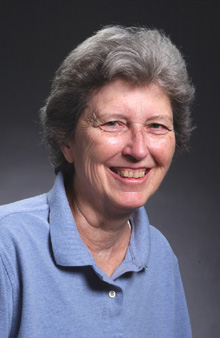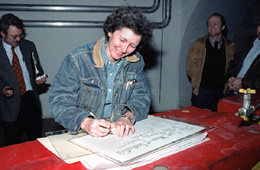 |
|
Helen Edwards Receives 2003 Robert R. Wilson Prize from the American Physical Society by Mike Perricone
Helen Edwards, whose work in the early days of Fermilab is a foundation of past, present and future scientific achievements, and whose current work is helping shape the next generation of particle accelerators, has been awarded the 2003 Robert R. Wilson Prize by the American Physical Society. The award is named for Fermilab's founding director, Robert Rathbun Wilson (1914-2000), and was established in 1986 by friends of Wilson, and by the Division of Particles and Fields and the Division of Physics of Beams of the American Physical Society. Previous winners include Cornell University’s Maury Tigner (2000) and Fermilab’s Alvin Tollestrup (1989). “It is a great honor to receive the Wilson Prize,” said Edwards, who with her husband, Don, worked with Wilson first at Cornell University and then at the National Accelerator Laboratory, later renamed Fermilab. The 2003 award cites Edwards “for her pivotal achievement and critical contribution as the leader in the design, construction, commissioning and operation of the Tevatron, and for her continued contributions to the development of high gradient superconducting linear accelerators as well as bright and intense electron sources.” The award will be presented in April 2003 at the APS annual meeting. “I was delighted to learn that Helen Edwards had been awarded the Wilson Prize,” said Fermilab Director Michael Witherell.“Bob Wilson brought Helen to work at Fermilab, and both of them made essential contributions to the remarkable success of Fermilab and its accelerators. I’m very pleased that Helen’s work has been recognized in this way.” In a distinguished and much-heralded career, Edwards has been the recipient of a MacArthur Fellowship, the National Medal of Technology, and the Department of Energy’s E.O. Lawrence Award. She is a member of the American Academy of Arts and Sciences and of the National Academy of Engineering, and is a Fellow of the American Physical Society.
Edwards said she regards herself as part of a permanent team with her husband, Fermilab physicist Don Edwards, with Wilson holding a special place as their team leader. “My husband, Don, and I worked under Bob Wilson’s direction for over 20 years and we benefited greatly from his example,” Edwards said. “I believe this award is for my husband as much as for myself, as we have worked effectively as a team over the years. I have grown to appreciate Wilson’s leadership and convictions more and more over the years. Not only was he a great technical leader but he communicated his beliefs with great clarity. He lauded international collaboration and decried ‘creeping bureaucracy.’” She continued: “I can do no better than to excerpt some of his thoughts from his 1969 testimony before Congress, on building the Fermilab accelerator: ‘…(T)his new knowledge has all to do with honor and country but it has nothing to do directly with defending our country except to make it worth defending.’” The Tevatron accelerated its first beam in 1983, recorded its first proton-antiproton collisions in 1985, and provided the pathway for discovering the top quark in 1995. It has been named a national landmark by the American Society of Mechanical Engineers, for its pioneering use of more than 1,000 superconducting magnets. Still the world’s highest-energy particle collider, the Tevatron has the Higgs boson among its targets for Collider Run II. “To begin with, there was indeed a good bit of skepticism over whether [the Tevatron] would work,” she recalled.“By the time we were ready to turn it on, I was pretty confident that it would work, and work well. I think that had to do with the many iterations of testing things, installing, re-installing and getting all the engineering to work. It began as a fixed-target machine, of course, then two years later joined up with the Pbar Source to run as a collider. So there were two major steps involved.”
Edwards is conducting research in superconducting technology for one of the possible designs of an electron-positron linear collider, proposed as the next machine for the field of high-energy physics. She has been the leader of the Photoinjector Project, which used a superconducting radio- frequency cavity for the first time at Fermilab to accelerate an electron beam. The photoinjector is now the key element in the NICADD (Northern Illinois Center for Accelerator and Detector Development) collaboration between Fermilab and Northern Illinois University. Edwards also shuttles between Fermilab and Deutsches Elektronen Synchrotron (DESY)in Hamburg, Germany working on research and development for the TESLA superconducting linear collider. Don Edwards, who also works on the photoinjector project, edited the technical design report for DESY’s TESLA Test Facility in 1994. Helen Edwards is adamant about the goal of building a linear collider as an international laboratory. “Either we’ll build it as an international laboratory,” she said,“or we’ll have nothing."
ON THE WEB: |


